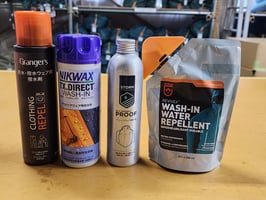For those of you who have purchased expensive outdoor jackets such as Gore-Tex jackets and have had...
How long can water repellency of rainwear last?
We already offer DWR treatment services in Japan.
The most frequently asked question is "How long will the water repellency last? This is a question that is difficult for us as technicians to answer.
As an engineer, this is a difficult question to answer.
This is because water repellency is not like an air freshener, which gradually decreases.
Water repellency does not decrease when water-repellent rainwear is stored in a closet.
The water repellency will only decrease when it is used or washed.
Therefore, as an engineer, I must be honest and tell you that it is up to you.
As expected, just saying "it depends on you" is irresponsible, so I show this in comparison with other water repellency treatments.
For example, the results of such a test show how many times longer it lasts when compared to ordinary waterproofing sprays.
As mentioned above, water repellency of rainwear decreases with use, but there are three main factors that contribute to this decrease.
There are three main factors: (1) deterioration due to dirt adhesion, (2) deterioration due to water absorption, and (3) deterioration due to abrasion.
Different factors require different countermeasures. This is a topic for another time.
PFAS-Free Changes the Persistence of Water Repellency
In the past few years, there has been a switch to fluorine-free water repellency. Therefore, you may feel that your new rain jacket is less water repellent than before, even though you purchased a new rain jacket. Or you may feel that the water repellency quickly degrades.
These problems are caused by the switch to PFAS-free, or non-fluorinated water repellency.
The performance of fluorinated and non-fluorinated products differs greatly.
Unfortunately, both the ability to repel water and the sustainability of water repellency have decreased.
This is due to chemical principles.
How to maintain water repellency?
So now that we are PFAS-free and water repellency has decreased, is there anything we can do about it?
No, there are still things we can do.
For one, there is still research and development going on around the world, including ours, to improve the water repellency and sustainability of water repellency in the current PFAS-free system. It will take time to develop better technology. Please wait patiently.
The second is for users to maintain better conditions by performing DWR treatment on a regular basis.
The current PFAS-free DWR process also requires effort on the part of users. Please keep in mind the importance of regular care.
Conclusion
The correct answer to the question of how long the water repellency of rainwear lasts is that it depends on the conditions of use.
At the same time, we have had to make an effort to maintain water repellency as we have become PFAS-free. Please keep in mind that we are still in the process of developing water repellency that is more resilient and more sustainable.


.jpg?height=200&name=vol03(1).jpg)
.jpeg?height=200&name=AdobeStock_69850861(1).jpeg)